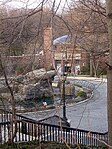Concert Grove
Buildings and structures completed in 1847Former music venues in New York CityIndo-Saracenic Revival architecturePavilions in the United StatesProspect Park (Brooklyn) ... and 2 more
Sculpture gardens, trails and parks in the United StatesUse mdy dates from October 2019

The Concert Grove is a section of Prospect Park, Brooklyn, New York City, that historically functioned as an outdoor music venue. It still serves as a sculpture garden lined with busts of musical figures, largely put up by German American Sängerfest participants and other cultural groups. The Concert Grove also includes the Concert Grove Pavilion, formerly known as the Oriental Pavilion, and adjoins a Lincoln sculpture facing the lake.
Excerpt from the Wikipedia article Concert Grove (License: CC BY-SA 3.0, Authors, Images).Concert Grove
East Drive, New York Brooklyn
Geographical coordinates (GPS) Address Nearby Places Show on map
Geographical coordinates (GPS)
| Latitude | Longitude |
|---|---|
| N 40.6592 ° | E -73.9643 ° |
Address
Concert Grove Pavilion (Oriental Pavilion)
East Drive 153
11225 New York, Brooklyn
New York, United States
Open on Google Maps









